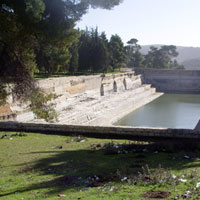 Solomon’s Pools in Artas are fascinating at many levels. An impressive feat of engineering in their own right, they are part of a unique water system which shows the hidden underground links between different parts of Palestine, links which are being severed at the ground level. In addition, they figure largely in the history and folklore of the village of Artas, bringing to the fore both the Judeo/Christian and Islamic traditions related to Solomon. Drained several years ago, due to many drowning by Artas boys, one is somewhat compensated for the loss of sight of the cool blue water among the fir trees, by the opportunity to study the three large reservoirs partly excavated from the rock, Collecting the runoff water from the springs of Wadi el Biyar, 10 km away, and the adjacent mountains, the pools have a total holding capacity of approximately 0.34 million cubic metres. For more than 2000 years, these pools served as a main source of water for Jerusalem, Bethlehem and the surrounding villages. A system of aqueducts and pipelines of closely fitted stone carried the water to Herodium and also to Haram el-Sharif area in Jerusalem. On the outskirts of Bethlehem, traces of two Roman aqueducts remain. The older one was built under Pontius Pilatus, procurator of Judea (26-36 A.D). Starting near 'Ain 'Arrub, it ran along the hillsides past Solomon's Pools, reached Bethlehem through a tunnel, and then went up to Jerusalem to the Al-Aqsa Mosque area. Formed by cubic blocks of white limestone, the second aqueduct was built at the end of the 2nd century. Water was conveyed from a source called Bir Ed-Daragi not far from Solomon's Pools, running on ground level in some parts. Its remnants, not far from Rachel's Tomb, are found in the triangle formed by the fork of the road leading to Manger Street. Although attributed to Solomon, the pools are thought to date back to the time of Herod the Great (37-4 BC). Formerly, the Artas Folklore Center held international festivals in the first pool. One such festival featured artists from Turkey to Tunisia, and was attended by 15,000 people the first night. The pools are now part of the Solomon’s Pools Resort and Convention Center, currently under construction. Opposite the first of the Solomon’s Pools lies the Murad Fortress, built on the orders of Suleiman the Magnificent for the protection of Solomon’s Pools. It has served as a caravanserai for travelers on the Hebron Road, a barracks and a refuge for the villagers of Artas during “the seven massacres of Artas.” It is currently undergoing renovations as part of the Solomon’s Pools Resort and Convention Center.
Solomon’s Pools in Artas are fascinating at many levels. An impressive feat of engineering in their own right, they are part of a unique water system which shows the hidden underground links between different parts of Palestine, links which are being severed at the ground level. In addition, they figure largely in the history and folklore of the village of Artas, bringing to the fore both the Judeo/Christian and Islamic traditions related to Solomon. Drained several years ago, due to many drowning by Artas boys, one is somewhat compensated for the loss of sight of the cool blue water among the fir trees, by the opportunity to study the three large reservoirs partly excavated from the rock, Collecting the runoff water from the springs of Wadi el Biyar, 10 km away, and the adjacent mountains, the pools have a total holding capacity of approximately 0.34 million cubic metres. For more than 2000 years, these pools served as a main source of water for Jerusalem, Bethlehem and the surrounding villages. A system of aqueducts and pipelines of closely fitted stone carried the water to Herodium and also to Haram el-Sharif area in Jerusalem. On the outskirts of Bethlehem, traces of two Roman aqueducts remain. The older one was built under Pontius Pilatus, procurator of Judea (26-36 A.D). Starting near 'Ain 'Arrub, it ran along the hillsides past Solomon's Pools, reached Bethlehem through a tunnel, and then went up to Jerusalem to the Al-Aqsa Mosque area. Formed by cubic blocks of white limestone, the second aqueduct was built at the end of the 2nd century. Water was conveyed from a source called Bir Ed-Daragi not far from Solomon's Pools, running on ground level in some parts. Its remnants, not far from Rachel's Tomb, are found in the triangle formed by the fork of the road leading to Manger Street. Although attributed to Solomon, the pools are thought to date back to the time of Herod the Great (37-4 BC). Formerly, the Artas Folklore Center held international festivals in the first pool. One such festival featured artists from Turkey to Tunisia, and was attended by 15,000 people the first night. The pools are now part of the Solomon’s Pools Resort and Convention Center, currently under construction. Opposite the first of the Solomon’s Pools lies the Murad Fortress, built on the orders of Suleiman the Magnificent for the protection of Solomon’s Pools. It has served as a caravanserai for travelers on the Hebron Road, a barracks and a refuge for the villagers of Artas during “the seven massacres of Artas.” It is currently undergoing renovations as part of the Solomon’s Pools Resort and Convention Center.
Archaeological Sites
Solomon’s Pools
"THE TANGIBLE AND INTANGIBLE HERITAGE THAT EXISTS FROM PREVIOUS GENERATIONS PROVIDES A LINK BETWEEN PEOPLE AND THEIR PAST"
- Home/
- Inventory Of Sites/
- Archaeological Sites
- /Solomon’s Pools
Copyright © 2025. Centre for Cultural Heritage Preservation.



 O-Sense
O-Sense
